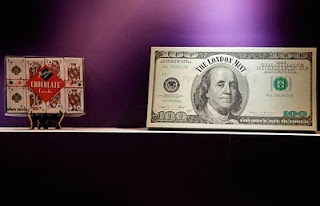1.Chocolate
In the group meeting I have introducing my idea for chocolate exhibition.
This idea generated from I researched the Expo 2010 Belgium pavilion's Chocolate Corner.
And then I have researched more about Chocolate exhibition.
As the first chocolate theme park in China, the Chocolate Wonderland will feature artefacts made from 80,000 kilograms of chocolate.
The Chocolate Wonderland is consisted of five indoor halls, including the World's Chocolate Hall, World's Candy Hall, Wonderland Theme Hall, Sweet Experience Hall and Sweet Gift Hall, as well as the outdoor activity areas of Sweet Stages and Sweet Shopping Street.
A large exhibition featuring a giant chocolate replica of the Great Wall of China, a replica of terracotta warriors, chocolate clothes and a car opened in Beijing.
Tons of chocolate, caramel and candies were used to create World Chocolate Wonderland.
Caramel plates
Chocolate Buddha
Chocolate shoes
Bags of leading brands
A BMW car that took some 2 tons of chocolate to be made
Organizers said the exhibition's goal is to allow visitors "to learn about the history of chocolate and its place in various cultures around the world."
The chocolate park opened shortly before the Chinese New Year. Its mascot, a tiger made of sugar, is thought to bring good luck and prosperity to the visitors.
Chinese porcelain made from sugar are displayed
A traditional robe made of chocolate
A dragon robe made of chocolate
Packs of cards and a 100 dollar bill made out of chocolate
And here are others image about World Chocolate Wonderland
2. Greener Living
The idea came up with we discussion.
The Greener Living will promote greener alternatives to all aspects of everyday living. Come along for practical advice on greener living and demonstrations of some of the latest technologies. See how you could save money and improve your health at the same time as helping the environment.
3. Chinese new year
This idea we have a little advantage that I am Chinese…
The Chinese character "fu" (meaning blessing or happiness) is a must. The character put on paper can be pasted normally or upside down, for in Chinese the "reversed fu" is homophonic with "fu comes", both being pronounced as "fudaole." What's more, two big red lanterns can be raised on both sides of the front door. Red paper-cuttings can be seen on window glass and brightly colored New Year paintings with auspicious meanings may be put on the wall.
Then people begin decorating their clean rooms featuring an atmosphere of rejoicing and festivity. All the door panels will be pasted with Spring Festival couplets, highlighting Chinese calligraphy with black characters on red paper. The content varies from house owners' wishes for a bright future to good luck for the New Year. Also, pictures of the god of doors and wealth will be posted on front doors to ward off evil spirits and welcome peace and abundance.
Hanging lanterns for Chinese New Year celebration is intended to get lucky.
Lanterns in three: hanging lights, put lights, lantern.
Hanging lights high in the beam, and illuminates the entire room, with bright, warm and peaceful, happy.
Mainly in order to put lights decorate the house, not much practical use, but also to enhance the festive atmosphere.
Lantern is thirty at night the children went house to house lights illuminate the road stopping, remember when the annual Spring Festival will be nice to buy a lovely new light, and small partners to stopping New Year. The lantern can be used not only to illuminate, but also take light bright future best wishes.
Temple Fair
The most important holiday for the Chinese is the Chinese New Year, also called the Spring Festival. During the festival period, everyone goes back to their hometown and spends several days with family, and people hold many celebrations.
Beijing has several fairs during the period. The fairs are held at various ancient temples, so they are called "temple fairs." Temple fairs, originated along with the development of Buddhist and Taoist activities, are a kind of mass gatherings that integrate religious worship, entertainment and commerce.
Temple fairs in Beijing have a very long history, and saw a boom especially during the Ming and Qing dynasties (1368-1911) as well as the Republic of China (1912-1949). Major temples all have their own festivals, some of which are held regularly. During the Spring Festival, temple fair is one of the most important activities, and a traditional cultural event that features all kinds of Chinese folk art. So far, there have been more than 10 major temple fairs held each year in Beijing.
In traditional temple fairs around Beijing, there are performances and booths demonstrating and selling traditional arts and crafts. The fairs have lots of games to play, food to eat, performances and lots of people. In the temple fair you can taste numerous kinds of local snacks, court food and other dishes.
Most temple fairs feature dragon and lion dances, waist drum dancing, lotus blossom fairy dances, ground and clam dancing as well as other folk performances, and some even stage traditional wedding ceremonies.
In rural areas, the temple fair is an excellent opportunity to capture some color in an otherwise fairly drab country.
For foreigners, temple fair is definitely a cultural experience, because it airs Chinese cultures from a very detailed perspective. While enjoying the samplings of Chinese delicacies, you can appreciate craftsmanship and artworks displayed by local artisans



































No comments:
Post a Comment